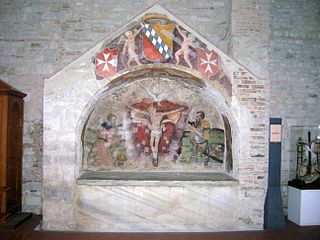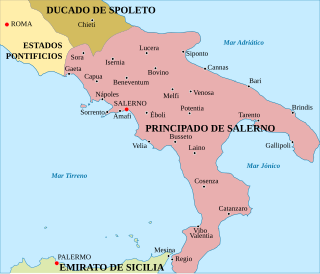Sources
- Norwich, John Julius. The Normans in the South 1016–1130. Longmans: London, 1967.
- Chalandon, Ferdinand. Histoire de la domination normande en Italie et en Sicilie. Paris, 1907.
Atenulf I (died 2 February 1062) was the Lombard count of Aquino who rose to become Duke of Gaeta in Southern Italy during the chaotic middle of the eleventh century.
Atenulf married the senatrix Maria, daughter of Pandulf IV of Capua, and his brother Lando married another daughter of Pandulf. [1] After the death of Ranulf Drengot, Count of Aversa, in June 1045, his cousin Asclettin succeeded in Aversa, but the Gaetans elected the Lombard Atenulf as their duke. Guaimar IV of Salerno, the suzerain of both Aversa and Gaeta, intervened on Asclettin's behalf and he defeated Atenulf in battle and took him prisoner. [2] At this time, however, Pandulf, the natural ally of Atenulf, was assaulting the lands of the abbey of Monte Cassino with Lando. Lando captured the abbot Richer and in return for the abbot's freedom and his assistance in battling Pandulf, Atenulf was freed and recognised in possession of Gaeta.
In Fall 1058, Atenulf's eldest son, who was betrothed to a daughter of Richard I of Capua, died. Richard demanded the dower nevertheless. The duke refused and consequently Richard besieged and took Aquino, one of the few feudatories of Gaeta remaining. Desiderius of Benevento, the new abbot of Montecassino, convinced Richard to extort only 400 sous from the duke, however.
Atenulf died in 1062 and was succeeded by his second son, Atenulf II. Aquino was ruled by all four of his sons: Atenulf, Lando, Pandulf, and Landulf.

William I of Hauteville, known as William Iron Arm, was a Norman adventurer who was the founder of the fortunes of the Hauteville family. One of twelve sons of Tancred of Hauteville, he journeyed to the Mezzogiorno with his younger brother Drogo in the first half of the eleventh century (c.1035), in response to requests for help made by fellow Normans under Rainulf Drengot, count of Aversa.

Guaimar IV was Prince of Salerno (1027–1052), Duke of Amalfi (1039–1052), Duke of Gaeta (1040–1041), and Prince of Capua (1038–1047) in Southern Italy over the period from 1027 to 1052. He was an important figure in the final phase of Byzantine authority in the Mezzogiorno and the commencement of Norman power. He was, according to Amatus of Montecassino, "more courageous than his father, more generous and more courteous; indeed he possessed all the qualities a layman should have—except that he took an excessive delight in women."

Pandulf I Ironhead was the Prince of Benevento and Capua from 943 until his death. He was made Duke of Spoleto and Camerino in 967 and succeeded as Prince of Salerno in 977 or 978. He was an important nobleman in the fight with the Byzantines and Saracens for control of the Mezzogiorno in the centuries after the collapse of Lombard and Carolingian authority on the Italian Peninsula. He established himself over almost the whole of the southern half of Italia before his death in March 981. He was an ancestor of Sancho I.
Rainulf Drengot was a Norman adventurer and mercenary in southern Italy. In 1030 he became the first count of Aversa. He was a member of the Drengot family.

Pandulf IV was the Prince of Capua on three separate occasions.

The Duchy of Gaeta was an early medieval state centered on the coastal South Italian city of Gaeta. It began in the early ninth century as the local community began to grow autonomous as Byzantine power lagged in the Mediterranean and the peninsula due to Lombard and Saracen incursions.
Asclettin Drengot was the son of Asclettin, count of Acerenza, brother of Rainulf Drengot, whom he succeeded in the county of Aversa in 1045. He was duly elected by the Norman nobles of Aversa and invested with the countship by his suzerain, Guaimar IV of Salerno.
Richard Drengot was the count of Aversa (1049–1078), prince of Capua and duke of Gaeta (1064–1078).
Docibilis II was the ruler of Gaeta, in one capacity or another, from 906 until his death. He was the son of the hypatus John I, who made him co-ruler in 906 or thereabouts.
Landulf I, sometimes called Antipater, was a Lombard nobleman and the Prince of Benevento and of Capua from 12 January 901, when his father, Atenulf I, prince of Capua and conqueror of Benevento, associated his with him in power.
Landulf II, called the Red, was the Lombard prince of Benevento and prince of Capua from 939 or 940, when his father, Landulf I, first associated him with the government. His mother was Gemma, daughter of Athanasius of Naples. He may have been associated as early as 933, when his elder brother, Atenulf III, was made co-regent. His uncle Atenulf II died in 940 and it is likely that Landulf served as a replacement. Landulf married Yvantia on an unknown date.
The Drengots were a Norman family of mercenaries, one of the first to head to Southern Italy to fight in the service of the Lombards. They became the most prominent family after the Hautevilles.

The Principality of Capua was a Lombard state centred on Capua in Southern Italy. Towards the end of the 10th century the Principality reached its apogee, occupying most of the Terra di Lavoro area. It was originally a gastaldate, then a county, within the principality of Salerno.
Atenulf II was the duke of Gaeta for a brief two years (1062–1064) under the regency of his mother, Maria. He was the son and successor of Atenulf I, who had been forced to recognise the suzerainty of the prince of Capua, Richard I, and his son Jordan in 1058.
Maria of Gaeta was an Italian regent, countess of Aquino by marriage and regent of the Duchy of Gaeta for her son in 1062–65.

The Norman conquest of southern Italy lasted from 999 to 1194, involving many battles and independent conquerors.
The Landulfids or Atenulfings were a noble family of Lombardic origin in the ninth through eleventh centuries. They were descended from Landulf I of Capua, whose own ancestry is unknown and who died in 843. The dynasty produced a line of princes which ruled most of southern Italy at one time or another and even one pope, Victor III.
Atenulf was the Abbot of Montecassino from 1011 until his death. He was a cousin of Prince Pandulf II of Capua, a younger son of Prince Pandulf III and brother of Prince Pandulf IV.